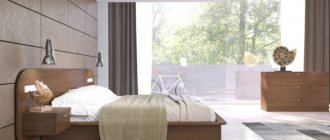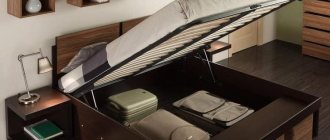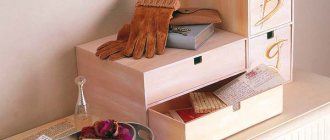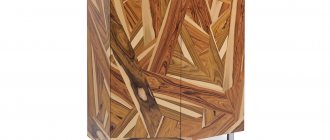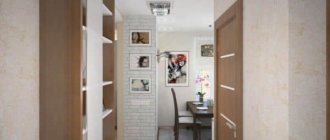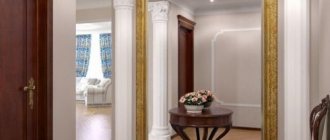Decorating a dressing room in the hallway, photo design
The hallway is an integral part of any city apartment or country house. The room plays a big role in creating the overall style of the interior and carries a certain functional load. An ordinary wardrobe cannot accommodate a huge number of personal items, seasonal outerwear or shoes, so the most popular solution is a dressing room in the hallway, design photos and useful recommendations are presented below.
Advantages and disadvantages
A multifunctional wardrobe cabinet looks stylish, aesthetically pleasing and has many advantages:
- solidity - when creating a built-in storage system, it is necessary to correctly calculate its dimensions so that all elements fit tightly to horizontal and vertical planes;
- compactness - in a small hallway it is difficult to install pieces of cabinet furniture that have strict geometric shapes. Therefore, installation of built-in modules is the only option for arranging a small space;
- affordable cost - when installing a built-in wardrobe there is no need to create a frame, it is enough to make a facade, so the price is significantly reduced;
- leveling of surfaces - a dressing room made to individual sizes helps to visually level out small deviations; ready-made cabinet furniture, on the contrary, will emphasize the slightest irregularities.
For all their attractiveness, built-in products have certain disadvantages:
- impossibility of transfer - the storage system built into the hallway is made taking into account all architectural features, the structure is difficult to install in another area;
- the need for repairs - reliable fastening materials are used during assembly, after dismantling it is necessary to carry out minor cosmetic repairs;
- complex assembly - the arrangement of the dressing room should be carried out by specialists with certain knowledge and experience.
When choosing furniture for the hallway, you need to take care of the spaciousness and functionality of all design elements. Drawers, convenient wicker boxes with lids or plastic containers are perfect for various accessories and hosiery products.
It is better to place open shelves for storing everyday items in an easily accessible place; it is recommended to place seasonal clothes on the upper floors. It is recommended to install a special narrow pencil case with separate square compartments for shoes or boots. High-heeled shoes can be conveniently placed on metal hangers.
You can significantly increase the functionality of your locker room by using compartments for scarves, ties or belts.
A full-length mirror, a small couch or ottoman will help create the most comfortable conditions while changing clothes. There are many options for arranging a dressing room in the hallway; the design and photos are presented below.
Corner
The convenient configuration is ideal for corridors with a small area. With a well-designed project, you can most rationally place the underwear and clothing of all household members. A corner dressing room in the hallway is the only option for creating voluminous storage in a small apartment.
Inside the modular design, a spacious storage system is created: spacious open shelves, pull-out compartments, metal rails for clothes. To prevent the structure from looking cumbersome, it is necessary to alternate open and closed areas. A modern, functional dressing room will be an ideal replacement for a full-fledged dressing room. Spectacular mirror surfaces of the facade will help to visually expand the space of the hallway.
In a niche
An architectural niche is a good option that allows you to arrange a spacious, functional dressing room without any special financial costs without disturbing the unity of the entire space. A separate room must fully correspond to the overall style and color scheme of the apartment.
According to the method of opening, doors in a niche can be hinged, sliding, folding or swinging. Particularly durable door leaf is made from natural solid wood. For modern interiors, you can use glass, plastic, mirror or laminated surfaces. To prevent the built-in dressing room from turning into a storage room for a large number of unnecessary things, it is necessary to review all the contents from time to time and, without regret, get rid of clothes that have already become unnecessary.
Open type
In a small hallway, the dressing room can have an open space - this will create the illusion of a spacious area. But it should be taken into account that all stored items will be located in plain sight; it is necessary to constantly maintain perfect order.
The entire storage system consists of wooden dividing walls and spacious open shelves, the uppermost and lower compartments are closed with doors. Decorative boxes or elegant wicker containers are used to store small items. In open-type dressing rooms, designers recommend placing a comfortable couch or a soft ottoman along the entire rack with shoes or clothes.
An open dressing room is a natural extension of the room, so they are decorated in the same style.
Closed
The length and width of a closed storage facility depends on the size of the corridor. But even in narrow hallways, where there is very little free space, you can install a compact version of the dressing room. The advantages of a closed storage system are quite obvious: things will not gather dust or become dirty, and there is no need to constantly put things in order.
In addition, in a conveniently equipped separate room you can try on clothes, get ready for the theater or work. Designers advise hanging a large mirror or placing a dressing table, and an ordinary dressing room will turn into a toilet room.
To properly organize a separate room, you need to think about its location in advance. The ideal option is to take advantage of existing niches. In addition, you need to consider the ventilation and lighting system.
An alternative to a dressing room in a one-room apartment - practical storage systems for clothes and shoes
If the area is limited, there is no point in making furniture from wood, MDF or chipboard into the wardrobe. They take up precious centimeters of space and also interfere with air movement. Another disadvantage is that redoing something is problematic.
“Standard” type furniture takes up too much space.
Recently, a general trend has been the installation of lightweight metal storage systems. They are modular and assembled on special racks. Racks can be attached in two ways - to the walls or to the ceiling and floor: different manufacturers make different systems. And everything that is needed is hung on these racks.
The racks can have notches along the entire length, which makes it possible to install any element at any height. These are the most mobile systems that can be modified easily and simply - simply by moving them from one row of notched hooks to another, arbitrarily changing the height of the shelves and baskets, and other elements.
Convenient modular system
There are racks of rectangular cross-section, with grooves cut on both sides. The necessary components are attached to the clamps in these grooves.
Different type of racks and different mounting system
Please note that there are different shelves and drawers - made of wood or wood materials, metal - chrome-plated or painted. They can be retractable, they can be placed one on top of the other or on shelves.
All these systems are sold: racks and a list of various components. But they are produced mainly in European countries, so the price is high. An economical option for dressing room equipment can be made independently from a round chrome-plated furniture pipe and various fasteners for it. It turns out that this furniture is not as mobile as we would like, but it costs significantly less.
Round furniture tube wardrobe equipment
In addition to standard and not so standard drawers and shelves, there are interesting special options. For example - skirts or trousers. Special guides on which the transverse strips are attached, sometimes they have clips. They allow you to hang your skirts/pants straight and not be afraid that they will fall. It is convenient if such a hanger extends, allowing you to inspect all the contents.
One of the options for filling a dressing room is a bracket for skirts or trousers
This device can be replaced with a simpler one, but much cheaper - a hanger with crossbars located one below the other. It's not as convenient, but it allows you to organize your clothes just as well.
Budget option for hangers for trousers and skirts
There is a retractable design for ties, only it is usually oriented differently and extends out in length, although not everyone likes such a system, but prefers folded drawers into cells.
Tie devices
There are several ways to place hangers. The simplest are pipes, the more economical (in terms of space use, but not in terms of money) are tie-like retractable brackets.
Pull-out brackets for clothes hangers
Another device is a pantograph for clothing. This is also a pipe, but capable of descending. A kind of lift for clothes. This device allows you to use the space right up to the ceiling, without compromising your comfort. It can be attached either to the side walls (the more common option) or to the wall.
Furniture pantograph - for light (by weight) clothes
Problems often arise with storing shoes: some people have dozens of pairs of them, so it’s time to arrange separate dressing rooms for them. But among the standard sets of equipment there are several interesting ones for storing shoes.
READ MORE: Do-it-yourself foundation for a house, step-by-step instructions
Let's start with the retractable system. IKEA has it. Pins with shoe modules mounted on a movable frame. Convenient, compact.
Retractable shoe system
There are mini chests of drawers that do not take up much space, but are hung on the walls, and there are hanging organizers that can be easily placed on a horizontal pipe.
Shoe storage systems in the dressing room
These are mini chests of drawers on the wall
In general, there are many interesting ideas for shoes that allow you to place them compactly and at the same time conveniently. Some are in the fogo gallery.
Wheel for storing shoes. Rotating round cabinet. The space in the corner is used perfectly. Such “rotating” boxes are very convenient not only for shoes, but also for small items and linen. The way to store boots is on hangers with clothespins Devices for compact storage of shoes Such systems are mounted on doors or walls
There are very inexpensive options. For example, the seasonal one, which is currently in use, can be stored on a grid with rearrangeable hooks or wire shelves. You've probably seen similar ones in stores. This is a mesh or perforated panel on which hooks/shelves are hung. Convenient: you can move it under any type of block, make the distance larger or smaller.
An economical option for storing shoes - a mesh with hooks and shelves
Hanging such a grid is not a problem - even on a wall, even on the side surface of a cabinet or door. Hooks and shelves simply cling to the crossbars. This option is ideal if you are short on money and space. If you like the idea but need something more presentable, make or find a perforated metal shield on the frame. Hooks are also inserted into it with a bang.
Modification - shield with hooks
In general, when arranging a dressing room and on a limited budget, you should look for storage systems not in furniture stores - online or offline. It’s better to look at sites that sell commercial equipment. There are many interesting devices that save space: stores also try to display the maximum amount of goods in a minimum area. For example, these are shoe racks.
Shoe stands
If you attach wheels to the first one, you get an excellent retractable system. The price of such equipment is much less than similar equipment, which is sold in furniture stores.
First, allocate a specific space for the room. It should be at least 2x2 m. In such a room it will be comfortable to prepare for going out, choose things and change clothes. Decide on the location. One of the most successful options is in the bedroom. In such a room there is almost always enough space for a small dressing room.
Theory is useful, but it's time to practice. Go to the store and buy all the necessary tools and materials:
- drywall with dimensions according to your calculations;
- roulette;
- level;
- metal scissors;
- self-tapping screws;
- perforator;
- metal profiles by size.
Now all this needs to be applied correctly. Just follow our step by step instructions.
- Clear the room of upholstered furniture and things. There will be a lot of dust, and space will be required for work.
- Mark the floor, ceiling and wall. The niche needs to be formed as evenly and accurately as possible.
- Install metal profiles. They must be securely attached to surfaces and connected to each other. It is necessary to create a reliable metal structure for drywall.
- Cut the drywall sheets according to your calculations.
- Attach them to metal profiles using self-tapping screws or other fasteners.
Further options for action are possible.
If you need to install a door, do it separately. Attach to another wall, fill the remaining space with sheets of plasterboard. Sliding doors require metal profiles on the floor and ceiling. The two sashes should be mixed on rollers along the profiles. With a curtain everything is simpler, just a rod at the top.
This is probably the most difficult stage, which will already require some knowledge in the field of interior design. Let's move on to the instructions.
- Initially, you need to hide all fasteners with putty. Pay special attention to the joints, they are the most difficult to deal with.
- Using putty, form perfectly smooth walls on both sides. You should get a full-fledged interior partition.
- After the putty has dried, sand the surfaces to remove excess and make the wall even smoother and more pleasant to the touch.
- Now apply a coat of primer to the surface with a roller.
- At the last stage, finish with wallpaper, paint or other coating.
It is important that the design of the dressing room in the niche fits well with the interior of the entire room. And this is where some design tricks will come in handy.
Practical storage systems for clothes and shoes include:
- roof rails;
- wall rods;
- floor hangers;
- hooks for doors and walls;
- special hangers for doors.
Let's look at each of them.
Railings
The rails can be mounted on any wall at any height (even in the hallway), which is convenient. Clothes hangers are placed on them.
Wall rods
Floor rods are practically the same as roof rails. This is a great way to prep clothes for the week ahead and declutter your closet a little.
The advantage of a wall rod is that it can be turned over and attached not to the wall, but to the ceiling.
Floor hangers
Floor hangers are available in the form of a stand with hooks and a rod on supports. On the second, you can use hangers that prevent clothes from getting wrinkled. Some models have compartments for shoes.
Floor hangers are made of metal and wood. The only difference is that the latter look more noble. But if a one-room apartment is decorated in high-tech style, then they will be inappropriate.
Hooks for doors and walls can be either inconspicuous or bright, lined up in one row or scattered in a chaotic manner. It all depends on your taste.
Hooks for doors and walls are ways to hold everyday clothes - blouses and skirts, T-shirts and jeans, little things like scarves and hats.
Decor
The most luxurious and expensive dressing rooms in the hallway are made from natural solid wood. When creating an economical option, modern materials such as laminated chipboard or MDF are used. Compartment doors are made of wood or durable glass, baskets for storing small items can be made of plastic, wicker or rattan.
Small dressing rooms should be decorated in light bed colors. If there are no window openings in the room, care must be taken to create artificial lighting. To do this, you can use a ceiling chandelier or successfully illuminate individual areas of the dressing room. LED strip and small spotlights look very impressive. Modern LED light bulbs will create soft diffused lighting. A well-equipped dressing room will allow you to properly organize the space and create a convenient, functional and comfortable storage system.
What should be inside?
A small dressing room will be significantly different from the rest of the rooms in your apartment, at least in size. Therefore, it is important to save every centimeter of space. There are several planning rules that must be followed to ensure that the area of a small room is used as best as possible.
- The shoe storage system should be placed on the lowest tier. You won't get your clothes dirty. It is best to use a mesh for this purpose, so that oxygen will be available to things.
- It is recommended to use the top shelves for things that you will not get out soon. These are seasonal clothes and those that you no longer use, but you still don’t dare to sell or give to someone.
- Casual clothing should be in the middle. It is within easy reach. To store it, it is recommended to use a crossbar with many hangers. Shirts, trousers, skirts and other short clothing will be placed here. The height should not be less than 1 m, width – 0.5 m.
- If there are a lot of short things and they don’t fit on one tier, buy a pantograph. With its help you will place such clothes in two tiers. If necessary, just pull the special handle and all the clothes will come down to you. You don't have to stretch or use a stepladder.
- Nearby you can place another compartment for outer and long clothes. It must be at least 1.5 m high. You can measure the longest outfit and choose a compartment for it.
- Be sure to use drawers. This is convenient for storing small items in cells, accessories, bedding and underwear.
- Several shelves are also useful for knitwear, tracksuits and home clothes. On wide shelves you can place things in several stacks, this is another opportunity to save space.
- If the size of the room allows you to organize a place for changing clothes, then it will be enough to take care of things. Try to fit a compact compartment for household appliances and an ironing board into your wardrobe system.
- If there is free space left, you can put a basket here for dirty things. Just use fragrances so that clean clothes do not absorb the unpleasant odor.
- You can put a small ottoman in the dressing room to make it easier to put on shoes.
If you listen to these tips, you will have a truly functional and comfortable dressing room.
Arranging a dressing room in the hallway: simple options and original solutions
It is impossible to imagine a home, especially if it is an apartment in a multi-storey building, without an entrance hall. When creating a general interior, they do not bypass this room. The main task is to give it functionality. In some versions, one could see a wardrobe in the hallway. But its appearance did not always fit into the interior, and its capacity is questionable. One solution is a built-in dressing room in the hallway. How to arrange it?
How to make a dressing room in the hallway with your own hands
Nov 15 • Uncategorized • 100 Views • No comments on the post How to make a dressing room in the hallway with your own hands
Contents
A dressing room is not only very practical, but also fashionable: everyone around will gasp when they see how carefully you treat your own things! Not every modern apartment has space for a full-fledged room for storing clothes, and many settle on a compromise option - a dressing room in the hallway.
Wardrobe options for the hallway
Before you start arranging your wardrobe, you need to think through all the nuances. First of all, we are concerned about the capacity and functionality of the design. They provide not only a wardrobe, but also other elements: drawers, boxes and plastic containers.
The use of a closet involves storing things both for everyday use and for seasonal use. Easily accessible open shelves are suitable for permanent items. The space at the very top of the wardrobe is reserved for items that are used less frequently.
It is recommended to consider a pencil case. It is ideal for storing boxes of shoes. For convenience and general decor, be sure to add a couch and a full-length mirror.
In addition to functionality, they think about the appearance and location of dressing rooms in the hallway. In this case, the layout of the room plays a significant role.
With swing doors
The installation of a dressing room in the hallway with hinged doors suits the classic style of the interior. Its dimensions directly depend on how much space the hallway allows. The original appearance is achieved through a variety of fittings.
Working on the lighting
The most convenient option is cornice lighting or ceiling lighting around the perimeter. Individual spotlights can be placed in areas that require additional lighting: in niches or above the dressing table.
Even in mini-dressing rooms, and even more so in large ones, ventilation is necessary: in a closed room, a musty smell quickly appears, which no perfume can mask. Therefore, even when planning, find a way to make ventilation in the dressing room.
The principle of its design is no different: in the upper part of any of the walls, preferably further from the door, an exhaust hole is made into which a fan is inserted. The inflow is provided either into the gap under the doors or into special inlet openings located just above the floor level. They are closed with decorative grilles.
Principles for organizing ventilation of a dressing room through a bathroom
When choosing a fan, you should pay special attention to the noise level. Since dressing rooms are often located in or close to bedrooms, noise should be kept to a minimum. It can be controlled automatically or turned on/off using conventional or walk-through switches.
The lighting should be bright. Firstly, this is necessary to quickly find things, and secondly, dressing rooms are often used as fitting rooms to immediately see how well the selected items fit together. The mirror is usually placed on the door or mirrored doors are made. In this case, the light should be directed not only to the shelves and storage systems, but also to the fitting area.
One of the lamp options
You can use lamps of any type, but it makes sense to make them turn on from motion sensors. They opened the doors - the lamps came on, there was no movement, they turned off. There is another option for swing doors: there are lamps with buttons that light up when the door is opened and turn off when they are closed.
READ MORE: Screw wood splitters 30 photos features of cone models Carrot and Screw sizes of firewood splitters
By hallway size
The dimensions of dressing rooms for hallways directly depend on the free space. They can be small, or they can be a whole dressing room. Let's look at a few of their features.
Small wardrobe
If you have an apartment of standard sizes, in which the hallway is not very large, you can arrange a dressing room with an area of 4-5 m2. For residents of 2-3 people this is quite enough. With minimal dimensions, the dressing room in the corridor is reduced to an area of 2 m2, which by and large is no different from a regular wardrobe. The main thing is to rationally distribute the space.
Basic tips for organizing a small wardrobe:
- It is better to place it near the wall with the largest area.
- To save space, sliding doors are installed, preferably from floor to ceiling.
- The interior is filled with shelves, rails, shoe racks, baskets and boxes.
- Be sure to make sure that not a single square centimeter goes unnoticed.
- The shelves are placed right up to the ceiling. For ease of use, carry a stepladder.
If the design of the room allows, then you can also arrange a corner wardrobe in the hallway. The simplest option is to fence off the corner with a plasterboard partition and then install sliding doors. The shelves are mounted directly to the walls. This design has a triangular shape.
Let us also note the simplest option - an open mini-wardrobe. Occupies a small space near the door. Consists of a minimum of elements: a shelf for shoes, a rail with hooks and an upper shelf for hats.
Large wardrobe
In the case where there is a lot of free space in the hallway, a large dressing room is arranged. To do this, a wall is built from a plasterboard partition and a door is installed in the opening. Within the allotted space, you can experiment and distribute shelves, drawers and hanging rods at your discretion.
But to make everything look modern, it is recommended to listen to the opinions of experts:
- For a large dressing room, several rods are installed to store clothes on hangers. Their placement is carried out at different levels.
- The more drawers you can arrange, the better. They can be decorated in a different color. Recently, the arrangement of wicker or plastic baskets has become very popular.
- Shelves are an indispensable attribute. There should be a lot of shelves in the dressing room.
- To place shoes, there is a compartment that is narrow and high in appearance. It's called a pencil case. Shelves are installed directly in it.
- We should not forget about the placement of ties, scarves and other accessories.
- The highlight of the dressing room is the full-length mirrors and the presence of a soft pouf for convenience.
Dressing room in a niche - tips for arrangement
Dressing room in a niche - tips for arrangement
Do you need a separate dressing room, but don't have enough space for it? Let's build a niche, and in it - a small dressing room. Or maybe the niche is already ready? Then read the article about arranging a niche for storing things. It will be useful for owners of both small apartments and spacious apartments.
Dressing room in a niche, or built-in wardrobe
What is a niche? These are three walls, a floor and a ceiling. No niche? Drywall to help us! One wall of the room is the side of the cabinet, the other is its back wall, and the second side will be built from plasterboard. Now we will finish the inner surface of the closet with the same materials as the rest of the apartment. We will treat the surface of the walls with a primer, then with decorative plaster or wallpaper. All that remains is to add doors and the built-in wardrobe is ready. We equip the closet with a storage system - that’s a dressing room!
Let's look at some of the questions that clients most often ask us.
How to choose built-in wardrobe fronts
Let's answer the main question. What is better: buying sliding doors or installing standard swing doors? For a wardrobe in a niche, we recommend installing sliding doors, their second name is sliding doors.
Their advantages:
- ease of installation;
- saving space in a cramped room or corridor;
- easy maintenance of mechanisms;
- safety is a fundamental factor for families with children (kids won’t get their fingers pinched or lock themselves tightly in the dressing room).
Another big plus: sliding doors have a ton of design options. Glass with photo printing, laminated chipboard of different colors, MDF coated with enamels, PVC film or high-gloss acrylic, mirrors, genuine leather... Your interior will be magnificent!
How to organize the interior space of a wardrobe in a niche
Carefully consider the storage system in your dressing room.
Sort men's, women's and children's items. For women's clothing, select a compartment with a rail for evening dresses, long coats and fur coats. Men need more shelves and hangers for trousers, jeans and knitwear. For children, purchase baskets and boxes for small clothes and linen.
Distribute all items according to frequency of use and seasonality. Hang your outerwear in the winter and put it on the top shelves in the summer. Put summer clothes for winter in boxes and send them to the mezzanine, swapping them with winter clothes.
It will be easier to put together a suitable outfit if you sort all the clothes you wear by color. Place boxes of out-of-season shoes on the lower shelves, and for those you wear constantly, purchase special inclined shoe racks.
Remember, the middle part of the wardrobe in the niche is a place for seasonal and frequently used items. Place out-of-season items for storage on the upper mezzanines, and shoes on the lower shelves.
The ARISTO wardrobe system makes it easy to organize the interior space: you don’t need to drill into the walls for shelves or figure out how to secure them so that they stay firmly on the wall. Everything is much simpler: install metal racks to which baskets, retractable systems, and mesh shelves are attached. The system is assembled simply, like a construction set.
How to use a balcony or corridor to organize a dressing room
Where else, besides the room, can you arrange a dressing room? Pay attention to the corridor and balcony (loggia). A built-in wardrobe will confidently take its place in a long corridor. Please note that with a corridor width of up to 1.3 m, the cabinet depth is 45-50 cm.
The corridor is more than one and a half meters? You are lucky: the cabinet depth of 60 cm will not interfere with free passage. In the hallway you can build a niche, or put a regular, free-standing wardrobe.
Do you have a spacious loggia? Here's another place to install a built-in wardrobe - a glazed and insulated loggia. The sliding doors will be narrow, approximately 50-60 cm each. An option is to make a built-in wardrobe in a niche with hinged facades.
To prevent the closet from blocking the source of natural light, place it along the side walls. Place rarely used items, supplies, household and sporting goods in your closet.
Dressing room in a niche: 5 useful tips
1) In a dark, cramped room, use translucent glass doors for the front of a wardrobe. This will visually expand the room and lighten the design of the cabinet. 2) Built-in lighting sources and a dressing room will transform, and help you find any item. 3) Use the dressing room as a gym if the niche area allows you to place exercise equipment in it. 4) Put a label on the boxes with things that you will put upstairs. If there are boots in the box, write BOOTS, or draw a picture of a boot by hand and stick it on the box. Now it's easy for you to find the thing you need. 5) Use the help of professionals, save your time - it is more important than money!
Our consultants have extensive experience in organizing dressing rooms, including in niches. You don't need to worry about anything: one call and a specialist will come to you. He will take measurements, discuss all the nuances with you, and make a project. You will be surprised how easy it is to resolve issues with a professional: your niche will turn into a well-organized repository for a lot of things!
Call us, we are always happy to help you!
Where to place the built-in wardrobe
The best option for the price is a built-in wardrobe option. Some of its advantages over cabinet furniture are also noted:
- reduction of elements, which significantly reduces the cost of the structure and simplifies installation;
- increased stability, so it is impossible to tip it over;
- solidity of the structure, since the back and side walls act as elements of the dressing room;
- The built-in wardrobe fits perfectly into any interior.
Such a cabinet is best built in large niches, or, if there are none, next to the wall with the largest area. If space allows, you can install it opposite the front door. In addition, in very spacious rooms, sometimes a built-in wardrobe can act as a partition wall.
Hallway design with dressing room
Everyone wants to have a spacious hallway with a convenient dressing room. But this is not always real. When creating an interior, you have to start from what you have. There are several design options for hallways with a dressing room. Ideas can be viewed in the photos below.
In addition to the structure and shape of the dressing rooms, their design is important, which can be supplemented by the following variations:
- accessories, the variety of which is not decently large;
- the presence of mirrors with different decorations;
- variety of lighting: spotlights, LED lighting, etc.
There are quite a lot of examples. You can view them on the Internet in photos and, if desired, create your own individual project. You can also contact designers who will definitely give practical advice.
What to consider when choosing a dressing room and wardrobe (2 videos)
Features and Benefits
A wardrobe can be an entire room or a small closet. In both cases, it has a number of its own features and advantages:
- Compactness. A small, neat wardrobe can fit even in a very modest-sized hallway. Most often, built-in models are used for this purpose.
- Availability. The modern variety of construction and finishing materials makes it possible to create very inexpensive models that will not put a big strain on the family budget and, at the same time, will cope perfectly with the tasks assigned to them.
- Convenience. A wardrobe is a place for simultaneous storage of a variety of things (clothes, shoes, gloves, hats, umbrellas, bags). It is much more convenient when all these items are in one place, and not laid out on different shelves, cabinets, racks, as is often the case.
In addition to these things, it is quite possible to store household and sports equipment in the wardrobe.
The advantages of a dressing room are:
- Aesthetics . Thanks to the work of designers, today every person has a unique opportunity to beautifully, originally, creatively decorate their hallway with a piece of furniture that also performs a significant functional load.
- Practicality. Wardrobes are usually made of very strong, durable, wear-resistant materials that do not require too much maintenance.
- Room adjustments. A built-in wardrobe is the ideal solution for filling a niche or small storage room that was not intended to be used in any other way. A wardrobe can perfectly disguise unevenness and imperfections in a wall. A mirror decorating a furniture façade will add light to a small room and visually expand it.
In addition to the advantages, there are several disadvantages:
- Impossibility of moving the built-in wardrobe to another place;
- Complexity of installation (built-in model);
- Despite its compactness, the wardrobe takes up enough space. This is especially noticeable within a narrow or small corridor.
Wardrobes may differ from each other in several ways (configuration, size, design, content, material, decor).
Corner dressing room
This option is most often used in small hallways. Often it is the only optimal option for arranging a Khrushchev corridor, for example. Well-thought-out internal filling allows you to carefully and most efficiently place the clothes of all household members.
To prevent the structure from looking too bulky, the internal system should combine open and closed modules, compartments, drawers, and shelves.
Open dressing room
Open dressing room. It is used for hallways of different sizes, but is preferable for small rooms. One of the advantages of this design is the feeling of free, bright space.
However, do not forget that all things and clothes will always be open to prying eyes.
This system consists of wooden or plastic shelving, spacious open shelves (there may be several shelves with doors in the lower part), wicker baskets, and drawers. Along the shelves or drawers with shoes you can place a small soft sofa or pouf. Very often, an open-type dressing room is a smooth continuation of the room, and therefore is decorated in the same style.
Closed dressing room
This storage system looks ideal in spacious rooms. The wardrobe can be very small or have several sections isolated from each other. The advantages of this type are obvious - things are laid out in a neat order, hidden from prying eyes, and dust does not fall on them from the outside.
If a closed dressing room is not just a closet, but an entire room, then it will be convenient to try on a new outfit or change clothes. The dressing room can be equipped with hinged or sliding doors.
The first option looks perfect in a classic interior. Of course, swing doors require a lot of space, but they can be given an original and stylish look with the help of interesting decorative items or beautiful fittings.
Sliding doors do not “eat up” space, are easy to use, and their wide, even and smooth surface can become an excellent basis for various decor options.
Built-in wardrobe
A built-in dressing room has a number of advantages over cabinet counterparts. Among them:
- The cost of the structure is significantly lower due to the saving of material on the frame, which is often replaced by the walls, ceiling and floor of the pantry or niche itself.
- Sustainability. It is impossible to knock over a niche, which cannot be said about a free-standing cabinet.
- Feeling of a holistic, monolithic structure. All wardrobe elements are very tightly adjusted to each other and to the room itself. In addition, a wardrobe located in a niche or closet visually enlarges a small space.
- Organic. The built-in dressing room fits perfectly into any interior.
- Optimality. An option with a built-in dressing room can sometimes be the only option for a room with a complex architectural form.
There are few disadvantages, but they exist:
- It is impossible to use a standard design (built-in wardrobes are made individually for a specific niche size);
- Difficult to install and assemble.
About the advantages
We save space in living rooms
A separate storage room will allow you to avoid cluttering up already not particularly spacious rooms with cabinets and other storage systems. Even in a one-room apartment with a layout that does not allow you to allocate part of the hallway for a dressing room, you can sacrifice part of the living space. It is better to put a chest of drawers in the room for linen, and move the main clothes to the dressing room.
Maintaining order
It is more convenient to store and sort clothes if they are collected in one place. Ideally, you can iron in the dressing room.
Save time on getting ready
It’s more convenient to change clothes - quickly and privately - here, when all the clothes are at hand. In addition, if you don’t change clothes in your rooms, there will be less dust there.
Filling the space to the maximum
The space of the dressing room can be filled as much as possible with storage systems, using the entire height of the walls.
And using a mobile clothes rack will allow you to use the entire perimeter, because if necessary, the rack can be moved.
We will equip it gradually
Outfitting a walk-in closet can be less expensive than buying built-in or pre-built cabinets. In addition, this room can be equipped gradually. You don’t have to put up a stationary wall or install a door, but separate the dressing room from the main room with a thick curtain on the ceiling cornice. This technique will allow you to maintain natural ventilation; textiles will add comfort to the interior.
We also use it as a utility unit
In a separate, albeit small, dressing room, you can select a utility unit and store large and bulky items for which it is difficult to find a permanent place in the house.
Gazebo in the courtyard of your house
Materials
Today there are practically no restrictions on the choice of materials for creating and decorating a dressing room. These can be budget and luxury options for every taste and budget. Among the most used materials today: laminated chipboard, MDF, natural wood, metal, plastic, glass, mirror.
The most original looking models are those made in a combination of several materials of different textures, for example, wood and glass, plastic and photo wallpaper.
Wood is an excellent natural material that has long been very popular in the construction and decoration of houses, furniture creation, and interior design. Today, few people prefer to use solid wood to create wardrobe spaces, choosing more budget-friendly materials.
However, it is almost impossible to replace noble, beautiful, durable, “living” wood with its unique smell and healing properties.
Dressing rooms made of solid oak, beech, alder, ash, pine, maple are made to order. Such models have a number of advantages:
- Strength, durability;
- Excellent decorative properties;
- Environmental friendliness, safety.
Wood is a very malleable material. It can be used to create the most architecturally complex structures and carved decorative elements. It looks great in its natural form and is suitable for painting, pasting, tinting, and artificial aging.
A wooden wardrobe in any interior looks appropriate, expensive and dignified.
Types of dressing rooms
There are several main varieties.
Wardrobe in the hallway
Multifunctional, practical and mobile furniture, which, if necessary, can be moved to another place and thereby model the interior in a new way.
The photo shows a white wardrobe with hinged doors in the hallway in the interior of the house.
Built-in dressing room in the hallway
It has a holistic and monolithic appearance. An organic design built into a niche or closet allows you to save useful space in the room. In addition, such a dressing room will be the best choice for a corridor with a complex architectural shape.
The photo shows a corridor with a wardrobe built into the pantry.
Corner dressing room in the hallway
Trapezoidal, triangular or radial modular products are equipped with spacious shelves, drawers and crossbars for things. To prevent the design from looking cumbersome, it is appropriate to install a completely open or combined type of wardrobe. Designs with mirrored facades will help to visually increase the area of a small corridor.
Particularly noteworthy are semicircular products, which may have a concave, convex or wavy shape. Radius models look stylish, modern in appearance and add special sophistication to the interior.
The photo shows a corner dressing room in the design of a modern hallway.
Open dressing room
It is made in the form of wooden, metal or plastic racks, equipped with rails, baskets and hangers. Such a storage system takes up a minimum of space, gives the corridor a light look, but always needs to be in perfect order.
The photo shows a corridor in the interior of the house, equipped with an open wardrobe.
Closed wardrobe
It may be small in size or equipped with several isolated sections. This type of wardrobe allows you to neatly store things, hide them from prying eyes and protect them from dust. The design is complemented by doors, which are decorated with beautiful fittings, mirrors and other decorative details.
The photo shows a closed dressing room with sliding doors in the hallway interior.
What should a small dressing room be like?
Initially, it is important to decide on the goals of the dressing room. What space do you want to use for clothing storage? It can be in a corner, in a niche or closet, or it can also be a small area inside another room.
You can completely create an interior partition and create another room. It’s up to you to choose where it will be more convenient. The principle remains the same. We will present you with some useful recommendations for arranging a small dressing room.
- Corners in rooms are often used irrationally, and this is quite a large space! This is an excellent idea for Khrushchev buildings with limited space. In addition, in a cramped room, it will be inconvenient to enter the dressing room located closer to the center. You can fence off the space with plasterboard with finishing or make do with highlighting the area with color and a screen (portable screen). If the apartment has a dead-end area, even better.
- Try to make sure that you can turn around inside the dressing room. You should be free to choose your clothes for going out. The ideal option is a convenient place to change clothes. For these purposes, it is enough to allocate 4 square meters.
- The room must be dry without fail. High humidity will cause the room to develop an unpleasant odor over time. And such storage conditions are not suitable for clothes; they will serve you less.
- Make sure to install the mirror in a convenient place. Firstly, it will help to slightly visually expand the space inside the room. Secondly, it will fulfill its main function - to help you choose an outfit faster. The best place for a mirror is opposite the changing area. As a rule, it is placed on cabinet doors.
- If the resulting dressing room does not have enough space, you can abandon the doors. Just zone the space. As a result, you will get one, but spacious room, combined with a bedroom, hallway or living room.
The most important rule is to create a room in which you can recharge yourself with positivity for the whole day, walk out the door and face this world in a good mood. So think about maximum usability, layout and good design.
Hallway layout
In some projects of spacious corridors, the wardrobe can be separated by a false plasterboard wall and a door can be installed. This way you can create a separate dressing room in the hallway.
For a long and elongated room, a built-in model located along one wall is mainly used.
Organizing a wardrobe near the front door has significant advantages. This option makes changing clothes more convenient and eliminates the need to carry clothes across the entire apartment.
The photo shows the interior of a narrow modern hallway with a wardrobe built into the wall.
In a hallway that has a non-standard shape and has beveled corners, beams, various protrusions, etc., it would be appropriate to place a built-in wardrobe, which, unlike rectangular cabinet products, fits more organically into the space and saves square meters.
The photo shows a built-in wardrobe in a niche in the design of a small corridor.
The photo shows the interior of the corridor with a wardrobe located in the pantry.
Finding a suitable place
Unfortunately, in the one-room apartments of the houses that are being built now, there are no storage rooms, since they are simply not needed.
But our grandparents prepared all sorts of goodies for the winter, so in the one-room apartments in Khrushchev there are closets, sometimes even several. A dressing room instead of a pantry kills not one, but two birds with one stone. Firstly, you will have a place to store all your clothes and shoes and, secondly, you will finally throw away the garbage that has accumulated over many years and will no longer clutter your home with things that “what if you need it.”
For lighting fixtures, you can take a chandelier (main lighting) and an LED strip (additional lighting). Additional lighting is a real lifesaver when you need to get dressed or undressed while other family members are still sleeping.
As for the design, when buying paint, wallpaper or other finishing material, make a choice in favor of pastel colors, for example, white, milky, beige. Calm shades do not overload the room and give it lightness. Don't forget about mirrors. They are not only functional, but also visually expand the space, which is especially important for one-room apartments.
The inside of the closet door will hold scarves, belts and ties. Just glue on hooks or hangers.
Depending on the layout, in a typical one-room apartment you can always find 2–4 meters for a dressing room. Moreover, in such apartments now the walls are often partially dismantled, which makes it possible to implement almost any planning ideas. For example, you can arrange a dressing room behind the head of the bed or, if necessary, expand it at the expense of the corridor. And if you want more free space, then a small dressing room can even be in the center of the apartment.
Redevelopment: option 1
Redevelopment: option 2
Redevelopment: option 3
Where is the best place to place it?
The dressing room in the hallway can be arranged in different places. The location will depend on the area of the room, its planning features and design, as well as on the size of the wardrobe itself.
Dressing room in the hallway niche
Many corridor spaces initially have recesses and recesses in which it is appropriate to arrange a stylish homemade locker room. The wardrobe in the niche is designed in accordance with the surrounding interior. It is left open or complemented with hinged, sliding or folding doors. Select panels made of wood, plastic, glass, or install doors with a mirror or laminated surface.
The photo shows an open dressing room in a niche in the hallway interior.
In the corner of the hallway
Most often it represents the most optimal solution for the corridor in a Khrushchev apartment. Thanks to properly thought-out internal filling, this design can accommodate the clothes of all family members. A design with the letter p or g, a semicircular or trapezoidal model, will fit perfectly into the corner space.
Dressing room along the corridor wall
It is appropriate to place a large wardrobe near one wall in the hallway. A universal option in the hallway is a narrow dressing room in the form of a rectangular rack for outerwear, shoes and hats.
Hallway with shoe rack
A shoe rack is a must-have item in the hallway interior. It allows you to rationally store shoes, unloading the area in front of the front door.
The number and size of the shoe rack will depend on the length and width of the room.
The big advantages of this piece of furniture are that the shoes stored in it will not become dusty or dirty, no one will accidentally step on them, and the shoes will be protected from pets.
Shoe rack is a special place for storing shoes.
Shoe racks can be of open and closed types. The latter is often functionally combined with a bedside table.
Mirrors are a reliable assistant in expanding space.
Features of internal filling
The upper tier is occupied by hats, the middle section by outerwear, and the lower segment is distributed for shoes.
The main functional parts are rods or pantographs, as well as elements in the form of drawers, shelves, baskets, pull-out pants, skirts and special sections for household supplies.
The photo shows an option for the internal equipment of a dressing room built into a spacious niche.
The wardrobe is often equipped with shoe organizers, hanging baskets for accessories, belt holders or even a built-in iron holder.
Thanks to various accessories and fillings, it is possible to simplify the operation of the dressing room and encourage the maintenance of perfect order in it.
How to decorate a dressing room: design ideas
There is an unlimited number of both budget and luxury materials that allow you to create a stylish and original wardrobe design. The most popular solution is to use laminated MDF or chipboard, natural wood, metal, plastic and mirrors.
Mirrored facades are unique and can not only decorate the hallway, but also adjust its volume and level of lighting.
Inserts made of bamboo or rattan will add naturalness and a natural character to the interior. Designs that are complemented by photo printing with a variety of images that match the overall interior style look very advantageous.
The photo shows the interior of a hallway in an oriental style with a wardrobe, decorated with inserts.
A wardrobe with a glass facade decorated with painting, film stained glass, fusing, beveli, batik or fresco will look truly interesting and unusual.
A wardrobe in a classic style can be decorated with carved details, skirting boards or pilasters. For doors, patination and gilding are used, and special mesh is used to create an aged effect.
The photo shows a corner wardrobe with a glass matte facade decorated with drawings.
What to do if the hallway is small?
In a small corridor it would be appropriate to place the structure at an angle. For this purpose, a product in the form of a corner wardrobe or a rack with combined closed and open shelves is suitable. In some cases, the corner can be fenced off with a plasterboard partition and a doorway can be installed in it. This will create an ergonomic triangular-shaped wardrobe.
For a small or narrow hallway, arranging a wardrobe near a long wall is also suitable. Sliding compartment systems from floor to ceiling are installed across the entire width of the wall plane. The interior space is equipped with shelves, rails, baskets, shoe racks and more.
The photo shows a small hallway with a built-in closed wardrobe.
There is a mini-wardrobe, which is a compact open structure for storing the most necessary things, which is mainly located near the entrance. A small dressing room in the hallway includes elements in the form of a shoe rack, hangers or hooks, as well as shelves for hats.
